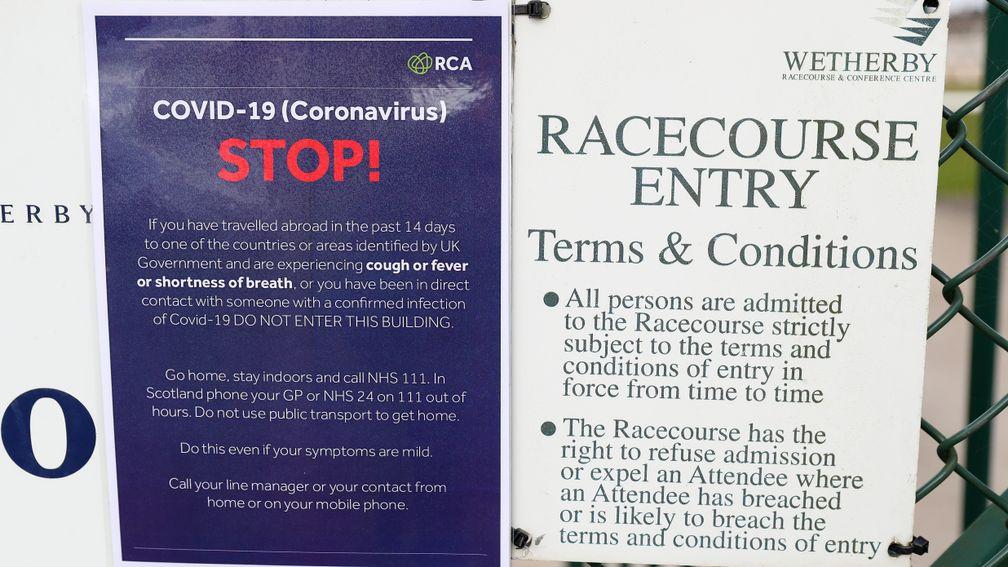Why we took the decision to shut down British racing
The BHA chief explains the reasoning behind the decision to halt the sport

This time last week we were enjoying top-class racing from Cheltenham. There had been pressure from some not to go ahead, but with support from government, our sport kept going, even though others had already stopped. Now we have come to a halt and I think it’s right to share some of the evidence that was considered by senior leaders and the BHA Board before they took that decision.
An industry group has been working on COVID19 for weeks now. Medical advisers from the RCA and the BHA have helped us look ahead, prepare for the worst, and advise on how racing could continue safely whilst it was possible. They have communicated the extraordinary pressures facing the NHS.
Monday’s announcement from Boris Johnson was the decisive moment. He said that from Tuesday 17th, the Government will not support mass gatherings, such as sporting events, which rely on the presence of emergency services. Later, the Health Secretary and Newmarket MP, Matt Hancock, told the Commons that Britain was ‘at war with an invisible killer’. Everything changed and it changed for racing too.
Within three hours, the racing industry group met. More than 20 senior leaders from all parts of the sport spoke late Monday and early Tuesday. Then the BHA Board met. This was some of the evidence heard by industry leaders and the BHA Board.
- A clear message from government to stop all gatherings that impacted upon emergency services (including ambulance services and their personnel, emergency departments and emergency care support inside the NHS).
- Direct evidence from RCA and BHA doctors on the reasons for that message, including the predicted unavailability of air and road ambulance cover due to deployment elsewhere and the risks of racing with NHS services under pressure.
- Indirect evidence from most of the 200 or so medical staff who work at racecourses. These were surveyed. Most have NHS roles and can see the pressures first-hand.
- Indirect evidence from senior NHS figures with knowledge of the pressures in the NHS. This includes doctors in senior positions and a senior administrator.
- Indirect soundings with key MPs supporting racing. The advice from pretty much all of them was to stop. They made it clear there would be little or no public or political support for a continuation.
- Assessment of the government’s approach. No direct instruction to racing was given. No direct instruction was given to other professional sports, or to pubs, restaurants, hotels or travel. Instead, the public was told to avoid all non-essential contact.
- Consideration of duty of care to racing staff. It was known then that many would have to look after elderly and sick relatives. Now we know there are children to look after as well.
In contrast, we had to balance the awful impact of the situation on people’s jobs and businesses. Thousands of livelihoods would be at risk with no certainty about when normal life would resume. All concerned shared their worries about the longer-term impact on ours and other industries. Most importantly, the implications for all those people working in racing were highlighted. Attention turned quickly to how the industry could muster the best possible support.
Also considered were the ramifications for the businesses and jobs that are indirectly dependent on racing. Our partners in the betting industry would be significantly impacted as would all those hotels, restaurants and bars that benefit from race meetings.
If we had continued, it was felt this wouldn’t be for very long – a few days at most – and we would have needed a plan to provide financial support to allow race meetings to continue. And there was a serious risk that racing would look out of step at a moment of national crisis.
By stopping now, the sport can best protect the health of the public, our own participants and staff. We can work on an immediate response to the inevitable hardship that all businesses and employees will face. (More details of the response were published on Thursday).
We knew that people right across our sport would be worried and anxious about the future. We are focused on working with government and racing bodies on financial proposals. We are already working on a recovery plan for when we can resume. Please, stay safe and support each other.
Read more
Livelihoods in the balance as racing counts the cost of shutdown
What have we lost? The key meetings that have fallen victim to British shutdown
Irish racing to continue behind closed doors after crucial Wednesday meeting
Saturday action at Thurles to be screened live on ITV4
Members can read the latest exclusive interviews, news analysis and comment available from 6pm daily on racingpost.com
Published on 19 March 2020inCoronavirus
Last updated 19:04, 19 March 2020
- 'We might be surprised about the racecourses that go - it's a precarious time'
- 'It's not all doom and gloom' - the long-term future of racehorse ownership
- Hysteria and dizzying change the only certainties for an industry under fire
- 'It will recover, it's only a question of when and how many casualties'
- 'I think we'll end up with fewer trainers than we've had for a long time'
- 'We might be surprised about the racecourses that go - it's a precarious time'
- 'It's not all doom and gloom' - the long-term future of racehorse ownership
- Hysteria and dizzying change the only certainties for an industry under fire
- 'It will recover, it's only a question of when and how many casualties'
- 'I think we'll end up with fewer trainers than we've had for a long time'